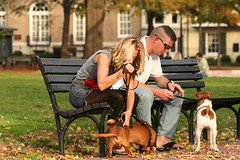 Located directly across from and north of The White House, Lafayette Park also known as Peace Park is part of the Lafayette Square Historic District which is an area of Washington DC that I plan to explore and focus more on in upcoming months. Though I have visited Lafayette Park since the fall of 1972 when after barhopping at the gay bars on 9th Street that friends Tom Wiley, Tom Ocfemia, Allen Aud and I would 'cruise' the park before returning back to Wiley's apartment in Riverdale MD and, in recent years, have photographed many demonstrations in what is sometimes referred to as Peace Park this image, taken on Veterans Day, 11 November 2006, represents the launching of my Lafayette Square Historic District Project which includes the H, 15th and 17th Streets surrounding area
Located directly across from and north of The White House, Lafayette Park also known as Peace Park is part of the Lafayette Square Historic District which is an area of Washington DC that I plan to explore and focus more on in upcoming months. Though I have visited Lafayette Park since the fall of 1972 when after barhopping at the gay bars on 9th Street that friends Tom Wiley, Tom Ocfemia, Allen Aud and I would 'cruise' the park before returning back to Wiley's apartment in Riverdale MD and, in recent years, have photographed many demonstrations in what is sometimes referred to as Peace Park this image, taken on Veterans Day, 11 November 2006, represents the launching of my Lafayette Square Historic District Project which includes the H, 15th and 17th Streets surrounding area
Tuesday, November 14, 2006
Lafayette (Peace) Park
 Located directly across from and north of The White House, Lafayette Park also known as Peace Park is part of the Lafayette Square Historic District which is an area of Washington DC that I plan to explore and focus more on in upcoming months. Though I have visited Lafayette Park since the fall of 1972 when after barhopping at the gay bars on 9th Street that friends Tom Wiley, Tom Ocfemia, Allen Aud and I would 'cruise' the park before returning back to Wiley's apartment in Riverdale MD and, in recent years, have photographed many demonstrations in what is sometimes referred to as Peace Park this image, taken on Veterans Day, 11 November 2006, represents the launching of my Lafayette Square Historic District Project which includes the H, 15th and 17th Streets surrounding area
Located directly across from and north of The White House, Lafayette Park also known as Peace Park is part of the Lafayette Square Historic District which is an area of Washington DC that I plan to explore and focus more on in upcoming months. Though I have visited Lafayette Park since the fall of 1972 when after barhopping at the gay bars on 9th Street that friends Tom Wiley, Tom Ocfemia, Allen Aud and I would 'cruise' the park before returning back to Wiley's apartment in Riverdale MD and, in recent years, have photographed many demonstrations in what is sometimes referred to as Peace Park this image, taken on Veterans Day, 11 November 2006, represents the launching of my Lafayette Square Historic District Project which includes the H, 15th and 17th Streets surrounding area
Friday, November 10, 2006
Survey Lodge Ranger Station @ GW Monument Grounds
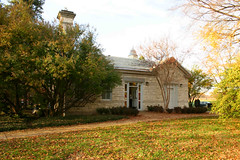 Some weeks back I would begin my Mission 66 Project which, at the time, is a term that I had found when searching the internet but now that I have a little more information I realize may be an inaccurate acronym. And, as a result but, in the future, I may refer to the series as the National Park Service Architectural and Infrastructure Project.
Some weeks back I would begin my Mission 66 Project which, at the time, is a term that I had found when searching the internet but now that I have a little more information I realize may be an inaccurate acronym. And, as a result but, in the future, I may refer to the series as the National Park Service Architectural and Infrastructure Project.En route to the Vietnam Veterans Memorial for the first installment of my Veterans Day 2006 Weekend Project I'd stop in at the National Park Service marble building located on Independence Avenue between 15th and 17th Streets, in SW, for the purpose of inquiring of the history of the structure as well as to inform the National Park Service of my now ongoing documentary project that will focus on the architecture and infrastucture not only on the National Mall but throughout the city and perhaps around the nation.
In these times of Homeland Security I must be extremely careful since, as a black male, it has always been my experience that racism plays a very important part in how folks react to me. And, thusly, to my photography. Which in my Friday, 10 November 2006 photoessay "I Saw A White Man Taking Pictures" I shed light on a situation that occured when I was photographing at the Vietnam Veterans Memorial. Which is the exact same reaction that I have encounted each time that I have visited or photographed at The Wall, since its November 1982 opening.
And since I put a deal of effort into my photography I have always returned home from documenting Rolling Thunder or Veterans Day at The Wall ... "mad as hell!".
Though I have passed by this building many times and have been fascinated by it in similar ways that, for many years, I've marvelled at what I would learn a few minutes later to be the Monument Lodge this would be the first time that I would actually enter the building which, according the sign out front is the Survey Lodge Ranger Station.
The Survey Lodge Ranger Station is actually where the National Park Service conducts and coordinates its volunteer services for sites located within the National Mall & Memorial Parks area. Upon entering the lobby and while the volunteer person behind the receptionist desk was in the process of assisting a man with a child in a baby stroller I'd take the opportunity to look around. The interior architecture is of an area that I find most interesting. And that I hopoe to learn more about and, of course, photograph.
Upon the departure of the man and child I'd approach the receptionist, informing him that in recent months I had embarked on an ongoing documentary photographic project that focused on the architecture and infrastructure of the National Parks Services with a particular interest on buildings such as the Survey Lodge. I would then ask if he knew the history or knew where I could find information pertaining to the history of such buildings as the Survey Lodge or the other building just across the way that for many years served as a concessions stand and public rest rooms.
Park Ranger Harry Gedney would then inform me that, for many years, he had researched, spoken on and written about the history of the National Capital Parks which includes the National Mall and surrounding Memorial Parks. The building on 15th Street, which I referred to as the concessions stand, he would explain is known as the Monument Lodge. While Mr. Gedney is not too informed of Monument Lodge's history he did say that the Survey Lodge which was built after the completion of the George Washington Monument had, actually, been constructed from unusued marble, left over from the construction of the GW Monument.
And when originally built, the Survey Lodge, served as the boiler and steam room for the operation of the elevators at the GW Monument.
After years of research, and under the auspices of the National Park Service, in 1996 Mr. Gedney would publish Synopsis of the Policy History of the National Capital Region. And as result Mr. Gedney was able to to refer me to several resources listed in his bibliography and references.
And just before rushing off to the Vietnam Veterans Memorial, Mr. Gedney, presented me with a copy of GEORGE WASHINGTON: Man and Monument by Frank Freidel and Lonnelle Aikman. Which I am most grateful for and will certainly refer to.
I left the Survey Lodge feeling uplifted and extremely happy that I had encountered Park Ranger Harry Gedney. I say this because when leaving my apartment for the purpose of visiting the Vietnam Veterans Memorial I'd reflect on my experiences, at The Wall, over the years. And, the fact, that would again leve The Wall, mad as hell!
Many have asked, 'If you have those experiences then why do you keep going back?".
On Friday evening, 10 November 2006, I would, again, leave The Wall ... mad as hell!
And, yet, I am very thankful to Park Ranger Harry Gedney who suggested that if I wanted to return to the Survey Lodge, after visiting The Wall that he may ould have more references to refer me to. While my concern was that, in the evenings, once the sun goes down, the chill in the air affects my bones what I did not express to Mr. Gedney was that, if history repeated itself, "... and as a result of the racism that I would experience at The Wall I would be in no mood, condition nor dispostion to revisit the Survey Lodge, later that evening."
On my walk home across the National Mall I would if Harry Gedney would understand that "in sharpt to my white counter part, as a 53 year old black man, I have less freedoms now than I had 35 years ago which was when my closet white friends and I would visit and tour the National Mall.
Thursday, November 09, 2006
Art on Call Project
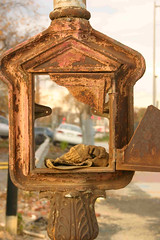 Police and fire call boxes were installed throughout the capital starting in the 1860s. Although they became obsolete with the introduction of the 911 emergency call system in the 1970s, they remained on the streets.
Police and fire call boxes were installed throughout the capital starting in the 1860s. Although they became obsolete with the introduction of the 911 emergency call system in the 1970s, they remained on the streets.Art on Call is a city-wide effort led by Cultural Tourism DC to restore Washington DC's abandoned police and fire call boxes as neighborhood artistic icons.
More than 20 neighborhood organizations are working on 301 call boxes as part of Art on Call. They have formed coalitions with residents and artists to propose, and then carry out, their ideas for refurbishing their neighborhood's call boxes.
Cultural Tourism DC and its partners have established a $250 matching grant for each proposal it approves. As of September 2005 $33,000 has been disbursed to fund 132 boxes. As of September 2005, 38 completed boxes were on view in Mount Pleasant, Capitol Hill, Dupont Circle, and Sheridan/Kalorama.
Art on Call is a project of Cultural Tourism DC in partnership with the DC Commission on the Arts and Humanities, the District Department of Transportation, and the Office of the Deputy Mayor for Planning and Economic Development.
For more information contact J. Brendan Meyer at BMeyer@CulturalTourismDC.org or 202-661-7581. Or visit Art on Call at Yahoo Groups.
The above photo was taken on 1 November 2006 at the corner First and N Streets, in SE, Washington DC which is directly across the street from the Washington Nationals (new) Stadium.
And in an attempt to preserve history, this particular call box which I have photograhed for several years, is a perfect canidate for the Art on Call Project. Three others of interest can be found at Half and M Streets, SW, and in the 1200 block of Delaware Avenue between M and N Streets, SW.
Wednesday, November 08, 2006
Demolition begins at Southwest Waterfront Mall
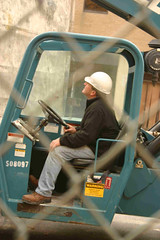 For several years, a banner proclaiming a new "Waterfront" development has hung over the Waterside Mall, at 401 M St., SW. Residents watched as mall stores closed in anticipation of the start of construction, leaving only a Safeway, CVS and a Bank ofAmerica branch. While internal demolition is finally underway, it is still unclear what will occupy this valuable piece of land once the development is completed.
For several years, a banner proclaiming a new "Waterfront" development has hung over the Waterside Mall, at 401 M St., SW. Residents watched as mall stores closed in anticipation of the start of construction, leaving only a Safeway, CVS and a Bank ofAmerica branch. While internal demolition is finally underway, it is still unclear what will occupy this valuable piece of land once the development is completed.
Monday, November 06, 2006
Washington Nationals Ballpark, 6 months later
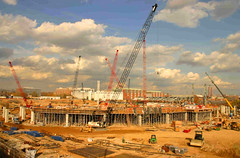
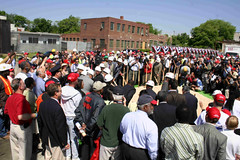
The first photo was taken on Wednesday afternoon, 1 November 2006 from the southeast pedestrian lane of the South Capitol Street Bridge between N and Streets in SE while the second was taken 6 months before on Thursday morning, 4 May 2006, at the corner of Half and O Streets, in SE, during the Washington Nationals Ballpark groundbreaking ceremony.
Subscribe to:
Comments (Atom)

